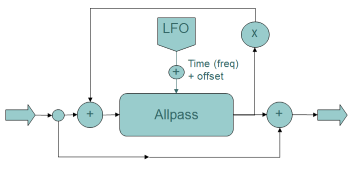Phaser
Since the Phaser and the Flanger have a similar sound, we will look briefly at the processing that makes up a Phaser effect. Where the Flanger use a variable delay time to create constructive and destructive interference, the Phaser uses another kind of filter to achieve the same kinds of interference, but with a higher degree of control over which frequencies the interference applies to. The filter used in a Phaser is called an allpass filter, it will pass all frequencies but it will change the phase of a specific band of frequencies. Since we can selectively shift the phase of the signal in a specific frequency range, we can control exactly where the peaks and notches will appear in the output spectrum.
"The phaser, or phase shifter, is closely related to the flanger in that it also works by sweeping notches through the spectrum of the input signal. While the term phasing is sometimes used synonymously with flanging [31], commercial phase shifters have been observed to implement nonuniformly spaced notches.4.3 We will therefore define a phaser as any linear filter which modulates the frequencies of a set of non-uniformly spaced notches, while a flanger will remain any device which modulates uniformly spaced notches." (Julius Orion Smith III. http://www.dsprelated.com/dspbooks/pasp/?urlkeywords=Phasing)

Since each allpass filter creates only a single notch (cancellation) in the spectrum, we need to add several of them to create the lush effect associated with a Phaser. At this point in the course we will not look into the design of allpass filters, so we will use an excisting building block in the Csound library to create a Phaser effect so we can compare the sound of Flanger and Phaser effects. Even if the placement of the notches is a principal difference between the Flanger and the Phaser, one could argue that the main difference in sound comes from the difference in implementation, where the allpass filter has the potential for a much smoother and more lush sound than what we can achieve with the variable delay line of the Flanger. However, the Flanger can inherently provide a small pitch modification and as such may have more of a warbling sound (adjectives to describe the differences are not assumed to be objective, see also the chapter on describing timbre).